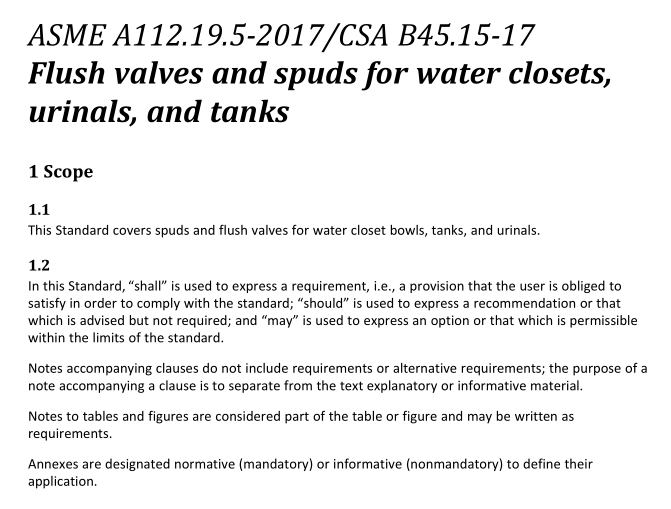ASME A112.19.5:2005 pdf download Trim for Water-Closet Bowls, Tanks, and Urinals
1 Scope
1.1This Standard covers spuds and flush valves for water closet bowls, tanks, and urinals.1.2
In this Standard,” shall” is used to express a requirement, i.e., a provision that the user is obliged tosatisfy in order to comply with the standard; ” should” is used to express a recommendation or thatwhich is advised but not required; and “may” is used to express an option or that which is permissiblewithin the limits of the standard.
Notes accompanying clauses do not include requirements or alternative requirements; the purpose of anote accompanying a clause is to separate from the text explanatory or informative material.
Notes to tables and figures are considered part of the table or figure and may be written asrequirements.
Annexes are designated normative (mandatory) or informative (nonmandatory) to define theirapplication.
1.3
sl units are the units of record in Canada. In this Standard, the inch/pound units are shown inparentheses.
The values stated in each measurement system are equivalent in application; however, each system is tobe used independently.Combining values from the two measurement systems can result in non-
conformance with this Standard.
All references to gallons are to u.s. gallons.
For information on the conversion criteria used in this Standard, see Annex A.
2 Reference publications
This Standard refers to the following publications, and where such reference is made, it shall be to theedition listed below, including all amendments published thereto.
ASME (The American Society of Mechanical Engineers)/csA GroupASME A112.19.2-2013/CSA B45.1-13
Ceramic plumbing fixtures ASME(The American Society of Mechanical Engineers)B1.20.1-2013
Pipe Threads, General Purpose, Inch
3 Definitions and abbreviations
3.1 Definitions
The following definitions shall apply in this Standard:
Flush valve – a valve located in a flush tank and used to flush a fixture by discharging water into thefixture.
Early closure flush valve – a valve in which the flush valve seal is adjustable to control the waterlevel.
Note: Usually, early closure flush valves are dependent on either a time delay or the distance that the waterlevel drops to control the level at which the flush valve closes.
Flush valve body – a fitting that contains a flush valve seat and a means of mounting to a fixture.
Note: The means for mounting the body can be threaded or non-threaded, and can be with or without an overflow.Flush valve seal – a component of the flush valve that mates against the flush valve seat to preventleakage when the flush valve is closed.
Note: Flappers are a type of flush valve seal.
Flush valve seat — the sealing surface of the flush valve body which, when mated with the flush valveseal, prevents leakage through the flush valve into the fixture.
Mounting seal – a seal between the flush valve body and the fixture.
Spud – a fitting used to connect a flushometer valve to a water closet or urinal.Note: Spuds are illustrated in Tables 1 and 2.
3.2 Abbreviations
The following abbreviations shall apply in this Standard:NPS – nominal pipe size
NPSM- National Pipe Straight Mechanicalpvc- polyvinylchloride
4 Design requirements
4.1 Rated temperatures
Flush valves and spuds shall be designed for rated supply temperatures between 5 and 43 °℃ (40 and110°F).
4.2 Threads
Pipe threads shall comply with ASME B1.20.1.
5 Performance requirements and test methods
5.1 General
5.1.1 Preconditioning
Before testing, specimens shall be conditioned at ambient laboratory conditions for a minimum of 12 h.
5.1.2 Installation for testing
Specimens shall be installed in accordance with the manufacturer’s instructions.
5.1.3 Flush valve assembly
5.1.3.1 Threaded
Threaded flush valves intended to be assembled to the fixture using a flush valve nut shall be tested in accordance with Clauses 5.3 and 5.4.
5.1.3.2 Non-threaded
Flush valves assembled to water closets by means other than threads shall be tested in accordance with Clause 5.4.
5.2 Life cycle test
5.2.1 Performance requirements
During and after the test, flush valves shall
a) continue to function as they did at the beginning of the test;
b) show no signs of leakage; and
c) not develop any defects that might adversely affect their functionality or serviceability.
ASME A112.19.5:2005 pdf download
